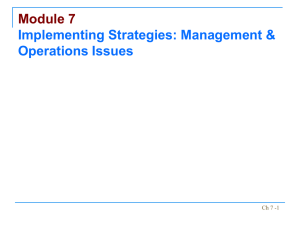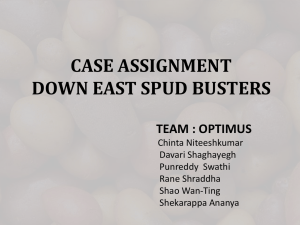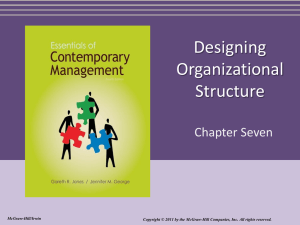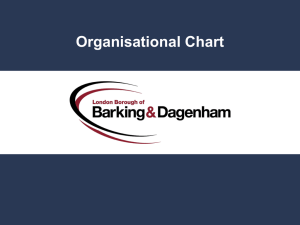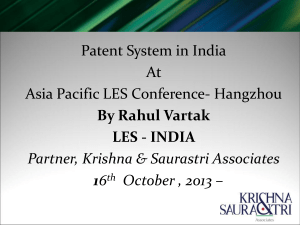Continuations and Divisional
advertisement
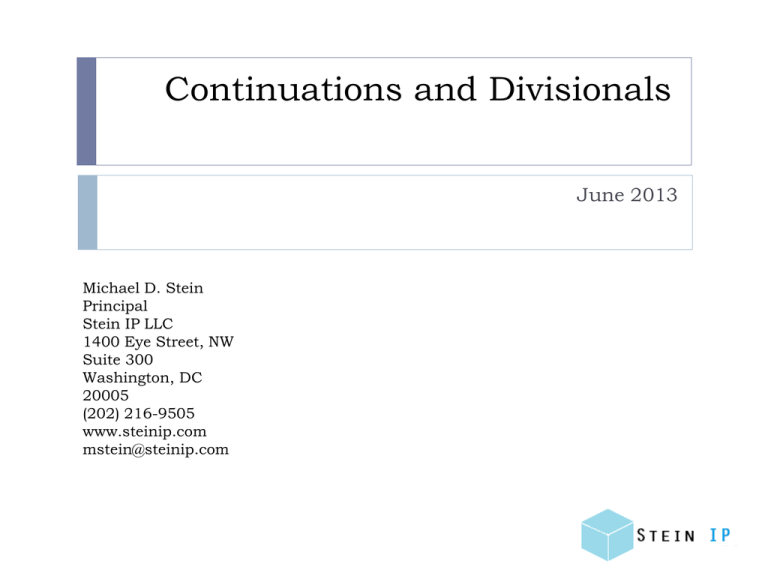
Continuations and Divisionals June 2013 Michael D. Stein Principal Stein IP LLC 1400 Eye Street, NW Suite 300 Washington, DC 20005 (202) 216-9505 www.steinip.com mstein@steinip.com Table of Contents The Statutes ............................................................................................................... Pre vs. Post-AIA Differences .................................................................................. Continuations and Divisionals ..................................................................................... Differences ............................................................................................................ Common Aspects ................................................................................................... Practical Difference ................................................................................................ Strategies When Considering Whether to File ............................................................ 1 2 6 8 8 11 12 13 35 USC 120 (Pre-AIA) 35 U.S.C. 120 (pre-AIA) Benefit of earlier filing date in the United States. An application for patent for an invention disclosed in the manner provided by section 112(a) (other than the requirement to disclose the best mode) in an application previously filed in the United States, or as provided by section 363, which is filed by an inventor or inventors named in the previously filed application shall have the same effect, as to such invention, as though filed on the date of the prior application, if filed before the patenting or abandonment of or termination of proceedings on the first application or on an application similarly entitled to the benefit of the filing date of the first application and if it contains or is amended to contain a specific reference to the earlier filed application. No application shall be entitled to the benefit of an earlier filed application under this section unless an amendment containing the specific reference to the earlier filed application is submitted at such time during the pendency of the application as required by the Director. The Director may consider the failure to submit such an amendment within that time period as a waiver of any benefit under this section. The Director may establish procedures, including the payment of a surcharge, to accept an unintentionally delayed submission of an amendment under this section. 2 35 USC 120 (Post-AIA) 35 U.S.C. 120 Benefit of earlier filing date in the United States. An application for patent for an invention disclosed in the manner provided by section 112(a) (other than the requirement to disclose the best mode) in an application previously filed in the United States, or as provided by section 363 which names an inventor or joint inventor in the previously filed application shall have the same effect, as to such invention, as though filed on the date of the prior application, if filed before the patenting or abandonment of or termination of proceedings on the first application or on an application similarly entitled to the benefit of the filing date of the first application and if it contains or is amended to contain a specific reference to the earlier filed application. No application shall be entitled to the benefit of an earlier filed application under this section unless an amendment containing the specific reference to the earlier filed application is submitted at such time during the pendency of the application as required by the Director. The Director may consider the failure to submit such an amendment within that time period as a waiver of any benefit under this section. The Director may establish procedures, including the payment of a surcharge, to accept an unintentionally delayed submission of an amendment under this section. 3 35 USC 121 (Pre-AIA) 35 U.S.C. 121 (pre-AIA) Divisional applications. If two or more independent and distinct inventions are claimed in one application, the Director may require the application to be restricted to one of the inventions. If the other invention is made the subject of a divisional application which complies with the requirements of section 120 of this title it shall be entitled to the benefit of the filing date of the original application. A patent issuing on an application with respect to which a requirement for restriction under this section has been made, or on an application filed as a result of such a requirement, shall not be used as a reference either in the Patent and Trademark Office or in the courts against a divisional application or against the original application or any patent issued on either of them, if the divisional application is filed before the issuance of the patent on the other application. If a divisional application is directed solely to subject matter described and claimed in the original application as filed, the Director may dispense with signing and execution by the inventor. The validity of a patent shall not be questioned for failure of the Director to require the application to be restricted to one invention. 4 35 USC 121 (Post-AIA) 35 U.S.C. 121 Divisional applications. If two or more independent and distinct inventions are claimed in one application, the Director may require the application to be restricted to one of the inventions. If the other invention is made the subject of a divisional application which complies with the requirements of section 120 it shall be entitled to the benefit of the filing date of the original application. A patent issuing on an application with respect to which a requirement for restriction under this section has been made, or on an application filed as a result of such a requirement, shall not be used as a reference either in the Patent and Trademark Office or in the courts against a divisional application or against the original application or any patent issued on either of them, if the divisional application is filed before the issuance of the patent on the other application. The validity of a patent shall not be questioned for failure of the Director to require the application to be restricted to one invention. 5 Pre vs. Post-AIA Differences For continuation/divisional applications, new declarations required if parent is a Pre-AIA application with old declaration No new declarations required if parent is a Post-AIA application with new declaration A copy of a power of attorney may not be used if a new applicant is being named in a continuing application, e.g., in the prior application the power of attorney was given by the inventors and the continuing application is filed by a juristic entity 6 Pre vs. Post-AIA Differences Continuation 7 Application with the same or similar specification as a parent application, where the continuation contains claims directed to a same invention as the parent, but have different scope Voluntary in that USPTO does not have procedure to force an applicant to file continuation Differences Between Continuations and Divisionals Divisional 8 Application with the same or similar specification as a parent application, where the divisional contains claims directed to a different invention as the parent, and have different scope Often involuntary in the way that a divisional is often result of restriction requirement issued by USPTO Examiner asserting claims to different inventions Applicant can also voluntarily file divisional By different invention, that can mean claims directed to a device vs. claims directed to a method, or claims directed to different species, or claims directed to different aspects of an overall invention Differences Between Continuations and Divisionals With restriction requirement, it is possible to attempt to traverse requirement, but still must make an election between the choices provided by Examiner Or one can simply make the election without traverse and file a divisional application for each different invention. Depends upon intentions and goals of applicant If application is a national stage application, then the Examiner is supposed to review the claims for “unity of invention”, which is slightly different standard than US practice, which is whether “two or more independent and distinct claims are claimed in one invention,” however, in practical terms, there is often little difference between national stage applications and non-PCt applications as to whether a restriction requirement is made 9 Differences Between Continuations and Divisionals With restriction requirement, it is possible to attempt to traverse requirement, but still must make an election between the choices provided by Examiner Or one can simply make the election without traverse and file a divisional application for each different invention. Depends upon intentions and goals of applicant If application is a PCT application, then the Examiner is supposed to review the claims for unity of invention, which is slightly different standard than US practice, however, in practical terms, there is often little difference between non-PCT and national stage applications as to whether a restriction requirement is made 10 Common Aspects of Continuations and Divisionals They can only be filed if the parent application has not issued. They cannot contain new matter that is not supported by the parent specification There is no limit to the number of continuations or divisionals that may be filed. A few years ago, the USPTO attempted to reduce backlog by limited number of continuations and divisionals, but that attempt failed in view of strong resistance by stakeholders (applicants) in the patent system 11 Practical Matter of Distinction As a practical matter, there is no distinction between calling an application a continuation or divisional. Each have same basic requirements, although applicant cannot get double patenting rejection if files divisional based upon restriction requirement Never had a case or heard of situation where USPTO or court complained that applicant called a child application a continuation instead of divisional or vice versa 12 Strategies When Considering Whether to File Continuation/Divisional Obviously, the more continuations/divisionals that are filed, the higher the cost due to filing fees and usually prosecution fees Filing a continuation(s)/divisional(s) has advantage of providing more weapons to use against competitor Allows applicant to keep some application pending so that claims can be added/amended years down the road to take into account competitor’s undiscovered or newly invented products/methods 13 Strategies When Considering Whether to File Continuation/Divisional Keeps competitors guessing as to full scope of claim coverage if they realize that at least one application still pending May receive double patenting rejection when filing a continuation(s) if claims are not patentably distinct, but can file terminal disclaimer Other than double patenting, parent, child or sister applications cannot be used as prior art since they will all share same priority date 14 Strategies When Considering Whether to File Continuation/Divisional Consider filing continuation(s) as late as possible 15 Often occurs just before issuance, and preferably before payment of issue fee. Can do the same when the continuation is almost ready to issue. Diffuses costs over time and stretches out process to see how market develops Also often occurs when some claims are allowable or contain patentable subject matter, while others are rejected. In this way, possible to get a patent on some claims which can be enforceable or used as threat or for licensing against others while allowing for further prosecution of rejected claims in continuation Strategies When Considering Whether to File Continuation/Divisional Consider filing many continuations/divisionals early on 16 Enables the likelihood that at least one continuation will be allowed early in the process Enables applicant to have multiple patents issue earlier on in the process File divisional as pre-emptive strike against Examiner’s possible restriction requirement, cutting down on overall prosecution time
